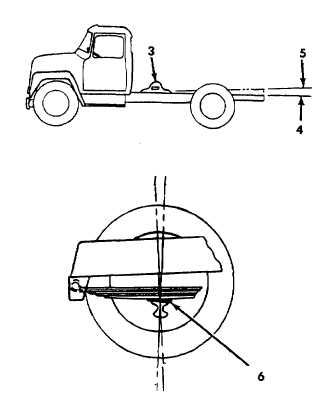|
| |
TM5-4210-229-14&P
4-162. TIRE RIM ASSEMBLY REPLACEMENT (Continued).
ALIGNMENT
a. Check caster angle.
(1) With the vehicle on a smooth, level surface, frame
angle should be measured with a bubble protractor (3)
placed on the frame rail. The degree of tilt from the
level frame position (4) is the angle that must be used
in determining a correcting caster setting. Positive
frame angle (5) is defined as forward tilt (front end
down) and negative angle as tilt to rear (front end
high).
(2) The measured frame angle should be added or
subtracted, as required, from the specified level
frame caster setting to obtain the caster that should
actually be measured on vehicle.
(a) Positive frame angle should be subtracted from
specified setting.
(b) Negative frame angle should be added to specified
setting.
NOTE
As an example, if the specified caster setting is a
positive 1° / and it is found that the vehicle has a
positive 1° / frame angle, then the measured
caster should be 0±1/2°. This would result in the
desired 1° /±1/2° caster angle when the chassis
settled to level frame under load.
(3) Caster adjustment is made by inserting a wedge (6)
between the spring and axle.
(a) To increase caster, insert the wedge so the thick
parts face the rear of the truck.
(b) To decrease caster, place the wedge so that the
thick end is toward the front of the truck.
If an excessively thick wedge is required for a
truck that has high mileage, check the contour
of the springs and replace springs if necessary.
b. Check camber angle (7).
(1) Camber is the amount in degrees that the wheel
inclines away from the vertical at the top, as
viewed from the front of the truck.
(a) Positive camber is an outward tilt or inclination
of the wheel at the top.
(b) Negative or reverse camber is an inward tilt of
the wheel at the top.
(2) An incorrect camber angle causes the side of the
tread to wear, resulting in abnormal tire wear.
(3) Unequal camber in the front wheels will cause the
truck to lead to the right or left. The truck will lead
to the side which has the most positive camber.
4-176
|

